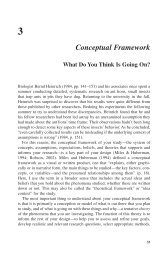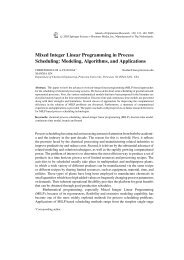Modeling and Calibration of a Structured-light Optical - Michigan ...
Modeling and Calibration of a Structured-light Optical - Michigan ...
Modeling and Calibration of a Structured-light Optical - Michigan ...
Create successful ePaper yourself
Turn your PDF publications into a flip-book with our unique Google optimized e-Paper software.
tu + ?2i + hi<br />
t\2 + ?22 + ^32<br />
'l3 1" J 23 T" '33<br />
?12'?13 + ^22'?23 + ?32 ''33 = 0<br />
(10)<br />
<strong>of</strong> which the top three are normality constraints <strong>and</strong> the fourth<br />
one is an orthogonality constraint (governs the orthogonality<br />
<strong>of</strong> the sensor Ys <strong>and</strong> Zs axis). We can also write Eq. (10) in<br />
matrix form,<br />
where<br />
R T -R =<br />
1 K\ K2<br />
K, 1 0<br />
K2 0 1<br />
" 1 — ?llf 12 + ^21^22 "t~ ^31^32<br />
K2 = fll^l3 + ^21^23 + ?31^33<br />
(ID<br />
(12)<br />
^ is the inner product <strong>of</strong> the first <strong>and</strong> second column vectors<br />
<strong>of</strong> the transformation matrix fT, thus represents the non-orthogonality<br />
<strong>of</strong> the sensor Xs axis <strong>and</strong> Ys axis. K2 is the inner product<br />
<strong>of</strong> the first <strong>and</strong> third column vectors <strong>of</strong> JT, thus represents the<br />
non-orthogonality <strong>of</strong> the sensor Xs axis <strong>and</strong> Zs axis. It can be<br />
shown that the two skew angles are uniquely determined by Ki<br />
<strong>and</strong> K2,<br />
ip = tan \K2IKX)<br />
= sin ' (VK? + /c|)<br />
(13)<br />
Were the coordinate systems orthogonal, the transformation<br />
matrix f T would have been orthonormal, which means that we<br />
should have had R T -R = /. When T is orthonormal, «i <strong>and</strong><br />
K2 approach zero <strong>and</strong> 9 becomes zero. This makes sense because<br />
6 is the skew angle <strong>of</strong> Xs axis. In the meantime, ip turns undefined,<br />
which is also true when the definition <strong>of</strong> ip is referred in<br />
Figure 4.<br />
To solve for the initial extrinsic parameters <strong>of</strong> the system,<br />
equate the corresponding terms <strong>of</strong> matrix fT in Eqs. (7) <strong>and</strong><br />
(8), twelve equations are found. Solving the 12 simultaneous<br />
equations, we have<br />
aa = tan" 1 [(tl3t32 - t^h^lih^ - t23tn)]<br />
(30 = cos" 1 Mi + '33<br />
, y„ = tair'tez/fss)<br />
(14)<br />
Subsequent angular motions <strong>of</strong> the pan-tilt device can be measured<br />
by the angular encoder as Aa, A/?, Ay. Then the current<br />
roll-pitch-yaw angles become a = a0 + Aa, p = /3a + A/3, y<br />
= yD + Ay. Knowing these angles, a new transformation matrix<br />
can be readily calculated from (7), thus saving subsequent<br />
calibrations.<br />
4 Sensitivity Analysis <strong>of</strong> Dimensional Deformation<br />
The nonhomogeneous coordinate transformation <strong>of</strong> the laser<br />
scanning process is not a shape <strong>and</strong> dimension preserving transformation.<br />
In this section, sensitivity analysis <strong>of</strong> deformation<br />
due to the two skew angles are performed by computer simulation.<br />
4.1 Euclidean Length Deformation. Given two arbitrary<br />
points P,(x[, y\, z[) <strong>and</strong> P2(^2, yk, Z2) in a 3D Cartesian<br />
space, e.g., the imaginary Cartesian sensor frame {S'}, it is <strong>of</strong><br />
interest to know how the distance between the two changes<br />
after the nonhomogeneous coordinate transformation. The coordinates<br />
<strong>of</strong> the same two points in the true skewed sensor frame<br />
598 / Vol. 118, NOVEMBER 1996<br />
{S} can be calculated from Eq. (3) as Pi (xt, yx, Z\) <strong>and</strong> P2 (x2,<br />
y2,z2). If the distance between the two points in Cartesian space<br />
is d\2, after the transformation <strong>of</strong> Eq. (4), the length deformation<br />
is<br />
where<br />
Adn(6, i},) = U\l + Dl2(d, i//) - d[2<br />
Dn(0,
















